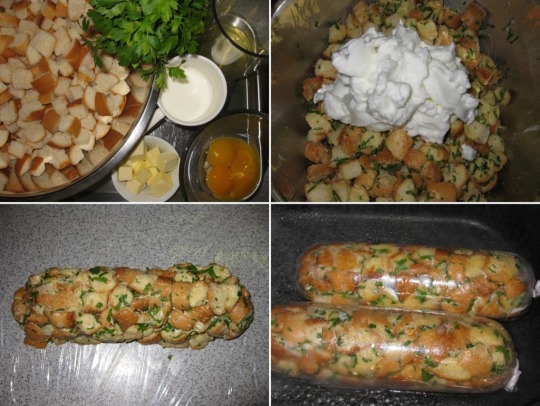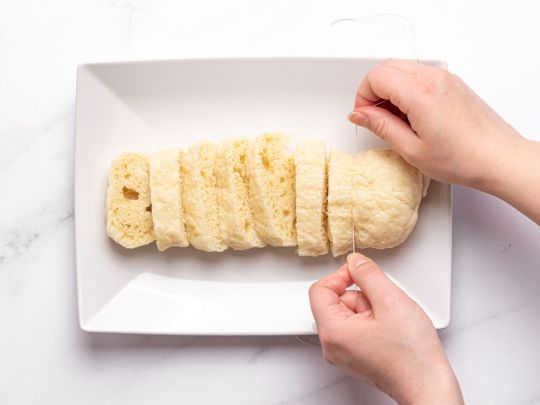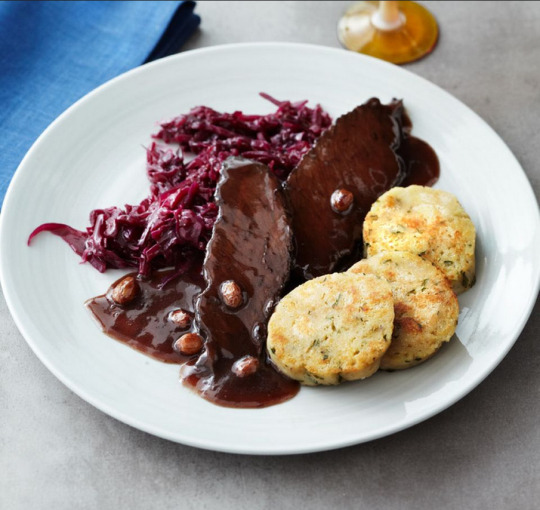#knoedel
Explore tagged Tumblr posts
Text
More Paprikahendl (a bit, anyway)...
@blyddyn asked this:
@petermorwood , a question for you. About a fortnight ago, I made a Gulyas and with it I served Huskovy Knedlik, thinking about it the Huskovy would go well with Paprikahendl. What are your thoughts on this?
Since that accompanied the reblog of a long-ish post, any reply other than something terse like "Sounds fine to me!" would have made it even longer.
Terse would of course answer the question nicely, but terse doesn't work very well with questions like that - at least not for me - so the fuller (as will be anyone who eats these goodies) reply is here:
*****
I'll be honest and admit I didn't know what Huskovy Knedlik were, until I looked them up and realised I do know them after all, by another name: Brotknödel (bread dumplings).
After learning that, IMO knedlik would go very well indeed with Paprikahendl, or indeed with any dish that has a rich gravy or sauce needing chased and mopped up to the last savoury drop. :->
By either name, they're a dumpling of flour, yeast, butter, eggs and milk made either round or in a fat sausage shape, poached in water or stock. The round ones are served whole, the long ones are sliced before serving.
On the right is a Czech huskový knedlík (Google translates it as "bun dumpling") while on the left is a German Böhmischer Serviettenknödel (Bohemian napkin dumpling).


Other versions use - indeed, ask for - yesterday's stale bread or rolls, cubed and fried golden then mixed with herbs, or bits of bacon, or chopped onion, and combined with the other dumpling ingredients before being wrapped to hold everything together during cooking.

This wrapper can be a piece of cloth, hence "napkin dumpling", though nowadays - as the photo shows - it's as likely to be cling-film.
The "clooty dumpling" of Discworld's Ankh-Morpork and the "clootie dumpling" of Thisworld's Scotland both get their names the same way - they're a cloth-y dumpling.
Simpler versions with fewer bits to fall off can be cooked without a wrapper, in a saucepan on the hob or, using a double-pan arrangement, water in a large pan and dumpling in a smaller then everything into the oven.
The slicing can be done with a knife, or with a piece of kitchen twine.

Here are a couple of English-language recipes. (One) (Two)
Ireland is currently sitting in the tag-end of another heatwave, but I can hear the initial rumbles and peas-on-the-roof rain of the thunderstorms that are supposed to end it, meaning autumn and hearty food is closer than it was last week.
So here's inspiration: Knedlik with goulash and raw onion garnish alongside Knödel with sauerbraten, capers (per @kommgehwech, they're raisins. Thanks!) and red cabbage.


Yum...
#food and drink#goulash#gyulas#paprika hendl#knedlik#knoedel#dumplings#Czech cuisine#clooty dumpling#Scotland#Discworld#GNU Terry Pratchett
79 notes
·
View notes
Text




https://pane-bistecca.com/2025/01/03/ruchbrot-knoedel-mit-pilz-hackfleisch-sauce/
#food#vegetables#meat#essen#gemuese#fleisch#Deutsch#germanfood#knoedel#brot#bread#altesbrot#kraeuter#herbs#zwiebel#onion#knoblauch#garlic#mushrooms#pilze#sahne#sauce
0 notes
Text
19:06
Had a short bit of time to watch some YouTube. That helped winding down.
The thing with my mum is that she's on Facebook a lot (not the bad bad part, though), and whenever she sees something interesting, she immediately talks about it and shows it to everyone. That means I usually can't really wind down when she's around. I always have to perform being interested at least a little. It's okay, I chose to do this, but this is only possible because I know that it's temporary and that I will be back home in my place in a little over a week.
We prepared the dinner we got from the restaurant. It was great and really easy, so I can highly recommend doing that!
It was the classic German Christmas meal of duck, knoedel, red cabbage, and brussels sprouts. For dessert, we had baked apples with marzipan and vanilla sauce.
1 note
·
View note
Text

A Raine (I LOVE YOU RAINE RAHHHHH) for @bookshopsandtea and a Hunter for an anon ask I got
Edit: forgot the silly Luz for @imperator-knoedel !
Give me a Steven Universe or Owl House character to draw today, I'm feeling sick and I want 10 tons of cartoon magic dumped into my brain
45 notes
·
View notes
Text

Terug in Duitsland. Vanavond maar weer naar de Mensa!
5 notes
·
View notes
Photo

☘️ Hascheeknödel ☘️ - so, wie früher 😍 Ich habe mir heute mal die Mühe gemacht unsere Hascheeknödel von Grund auf selbst zu machen. Zuerst das Haschee und dann den Kartoffelteig und zwar so, wie ich‘s als Kind jahrelang daheim im Mühlviertel gesehen und gelernt habe 😉 Herausgekommen sind dabei suuuuper flaumige Knödel mit feiner, schmackhafter Haschee-Füllung, begleitet mit Sauerkraut und Gulaschsaft 🥰 - ein Gedicht! Wer Nachkochen möchte, das Rezept habe ich für euch im Blog mitgeschrieben: https://www.private-taste.at/post/hausgemachte-knoedel #privatetastebyanita #privatetaste #privatetastebyanitamoser #knoedelliebe #hausmannskost #knoedel #mühlviertlerkost (hier: PrivateTaste) https://www.instagram.com/p/CklcPuPDrF6/?igshid=NGJjMDIxMWI=
#privatetastebyanita#privatetaste#privatetastebyanitamoser#knoedelliebe#hausmannskost#knoedel#mühlviertlerkost
0 notes
Photo

Regional German Food: Schweinshaxen also known as Sauhaxn from Bayern (Bavaria), Southern Germany, are roasted ham hocks aka pork knuckles. A variation of this is known in other parts of Germany as Eisbein, in which the ham hock is pickled and slightly boiled, but it’s not nearly as popular as in Bavaria and thus, is a “typical” Bavarian food to try. It originally is one of the old rustic peasant dishes from centuries past, in which inexpensive cuts of meat were made delicious through particular cooking methods. Such cuts generally require long periods of preparation in which the meat is marinated for days, sometimes even up to a week. The Schweinshaxe is then roasted at low temperatures for 2-3 hours. The Bavarian version is classically served with potato dumplings and red cabbage, or with sauerkraut and potatoes.
#german food#essen#food#bavarian#regional#regional food#schweinshaxe#schweinshaxn#sauhaxn#pork#meat#bayern#bavaria#alpine#rustic#peasant#dishes#knoedel#kloesse#typisch deutsch#southern germany#tourism#eisbein
71 notes
·
View notes
Photo

Vomp, Jens Schwarz
10 notes
·
View notes
Photo

Schwarzbrot Knoedel
3 notes
·
View notes
Text
Also humbled by not remembering the name of my favorite food (WHICH IS AN AUSTRIAN FOOD) while conversing with my German tutor. I couldn’t even remember knoedel I wanted to die
2 notes
·
View notes
Note
‘ there is never an end ’
between you and these bones prompts ;; accepting
@overthefjords
Sigh breezes past open lips, stained red in similar shade to liquid sloshing dangerously close to the rim of his wine glass. Roderich is draped over an armchair, back against one comfortable arm whilst legs are slung over the other, feet donned in thick warm socks and a blanket wrapped around his shoulders. Its a cold night, but a combination of beef goulash (with Semmel Knoedel of course) and a few bottles of Blaufränkisch has warmed him, loosened his tongue and made him sleepy.
"Ahh, ich glaub ich spinne. This life... you're right, there's never an end."
Another sigh, becoming increasingly common in the quiet living room. "Is this life? Aleks- you know, you go out and you live so well. You enjoy so easily, you are married because you love. You live such life."

He sips his wine, lets it sit in his mouth a second before swallowing, tasting the medium-body and spiced notes. Pretending to, anyway, as he is rather certain he is too inebriated to actually consider the taste.
"Can you tell me about it? Your marriage? Surely it helps, with the... never-ending-ness."
#;; rp { overthefjords }#;; verse { canon }#;; threads#;; drunk rod go brrrrr marriage#;; let this man marry half of europe again
1 note
·
View note
Text
Italians and Food - The North
The first thing to be understood is that northern Italy differs in an enormous way from southern Italy in terms of culinary distinction.
The North is filled with a great variety of dishes and outside influences. Visitors to Trieste will be offered Hungarian goulash as the local food, in Venice it will be Austrian pastries filled with Oriental spices, in Turin peasant-style dishes are served with sophisticated French sauces. If you want the best risotto, go to the Veneto and Piedmont; for pasta, Emilia; for rice and polenta, Lombardy. Sauerkraut and dumplings in alpine Trentino-Alto Adige, delicious vegetable-based cuisine in Liguria.
A typical meal for North Italians will mostly be made up of regional foods. They might eat pasta from Bologna, salad from Cremona, pizza from Pavia, eggs from Vicenza, veal and milk from Lombardy, basil from Liguria, flour from the Po Valley, Parmesan from Parma, and sugar and peaches from Ferrara. It is said that the further South you go, the better the gelato gets, but it is also true that the further north you are, the better the café. Turin, Trieste, Venice, Milan, and Padua have grand historic cafés of great warmth and elegance.
When the mists close in on Venice, comfort food suitable for sustaining people is required - thick soup or creamy risotto is popular. But the cuisine here can be very sophisticated, too, serving dishes such as risotto with shrimps, or carpaccio (wafer-thin raw beef with olive oil, rocket & parmesan). For seafood, soft shell crabs from Murano, plump red mullet, and pasta with lobster. As well as being a rice-growing region, the Veneto is Italy's main area for poultry, from chicken and goose to guinea fowl and duck. Offal, spicy black pudding, horsemeat, and capretto (kid) are also local delicacies, matched by whole-wheat spaghetti (bigoli), subtle cheeses, and honey.
Austrian influence prevails in Trentino/Alto Adige. Typical dishes include smoked meats such as Speck, sauerkraut, roast venison with polenta, red cabbage and goulash, and other filling stews. Dumplings are preferred to pasta, known as Canederli in Italian and Knoedel in German. A famous dish is Strangolapreti – gnocchi made of potato, bread, or spinach, coated with butter and cheese. Desserts are Austrian-inspired pastries like Apfelstrudel, a pie stuffed with apples, nuts, and raisins, or Sachertorte (a special chocolate cake).
Gorgonzola, the blue-veined cheese, originated in the foothills of the Alps near Milan. It's ideally served runny or as a sauce for pasta, polenta, or risotto.
Liguria is ideal for growing tomatoes, artichokes, peaches, apricots, and lemons. There is little meat and dairy production here, but a large array of fruit and vegetables are grown. Famous Pesto Sauce is from Liguria, made from basil, olives, and pine nuts or walnuts, ground with garlic and Parmesan. According to purists, it should only be made when basil is in flower. Liguria also produces the only olive oil to rival the finest Tuscan varieties.
Valpolicella, Soave, Barolo, and Barberesco are some of Italy's best wines, all from the North. The Veneto, covering the area from Venice to Lake Garda, is a significant wine producing region and plays host to VinItaly in Verona, Italy's largest wine fair. Prosecco, Bardolino, Valpolicella, and Soave are all from this region, as well as the famous firewater known as Grappa. Franciacorta is from Lombardy. Pinot Grigot and Riesling Italicoare from the Collio district of Friuli, Lambrusco from Emilia Romagna.
174 notes
·
View notes
Text
La fin de l'automne étant proche, je peux faire le bilan de la liste saisonnale.
- Manger des légumes de saison
- Aller au concert des Strumbellas
- Manger dans le restau où travaille Léa
- Boire du thé
- Regarder les feuilles tombées
- Mettre des vêtements chauds
- Finir l'Idiot de Dostoïevski
- Faire des knoedels aux questches
- Répondre aux lettres
- Me balader en forêt
- Voir des cervidés
- Être un peu plus inspirée
- Aller à au-moins un marché de Noël
- Donner de l'amour aux 3 monstres
- Aller écrire dans un café/bar
- Marcher plus souvent seule à travers les feuilles et l'automne
C'est vrai que c'était pas des choses compliquées à réaliser, mais j'avais besoin de simplicité. Je voulais simplement profiter de l'automne, avec quelques clichés qui font du bien.
Le seul point de la liste que je n'ai pas pu "cocher" c'est celui de guérir Oliver :/
Un autre point était celui de m'installer, assez vague, disons que je suis sortie souvent ces derniers temps et que je fais mes pas dans la ville D.
J'ai déjà écrit la liste pour la saison hivernale, elle est en soit assez simple, sauf que il y a pas mal de points liés à la neige et dans cette région la neige est rare. Quand j'en ai parlé au bar hier, ils m'ont tous parlé de la neige de 2012. Tellement rare que si une année il neige, ça les marque :)
2 notes
·
View notes
Photo

☘️ Hascheeknödel ☘️ - so, wie früher 😍 Ich habe mir heute mal die Mühe gemacht unsere Hascheeknödel von Grund auf selbst zu machen. Zuerst das Haschee und dann den Kartoffelteig und zwar so, wie ich‘s als Kind jahrelang daheim im Mühlviertel gesehen und gelernt habe 😉 Herausgekommen sind dabei suuuuper flaumige Knödel mit feiner, schmackhafter Haschee-Füllung, begleitet mit Sauerkraut und Gulaschsaft 🥰 - ein Gedicht! Wer Nachkochen möchte, das Rezept habe ich für euch im Blog mitgeschrieben: https://www.private-taste.at/post/hausgemachte-knoedel #privatetastebyanita #privatetaste #privatetastebyanitamoser #knoedelliebe #hausmannskost #knoedel #mühlviertlerkost (hier: PrivateTaste) https://www.instagram.com/p/Cklbjkuj-lY/?igshid=NGJjMDIxMWI=
#privatetastebyanita#privatetaste#privatetastebyanitamoser#knoedelliebe#hausmannskost#knoedel#mühlviertlerkost
0 notes
Text
Ndunderi - Verhaal van een Italiaanse knoedel
Ndunderi – Verhaal van een Italiaanse knoedel
Als je een Italiaanse Amerikaanse achtergrond hebt, is de kans groot dat je voorouders uit Zuid-Italië kwamen. Als u zich herinnert dat u uw grootouders of overgrootouders hoorde praten, weet u dat zij geen Italiaans "spraken", zij "zongen". Italiaanse zinnen die ik me uit de kindertijd herinner, zijn niet te onderscheiden als individuele woorden. Ze waren een stroom van niet te onderscheiden…
View On WordPress
0 notes